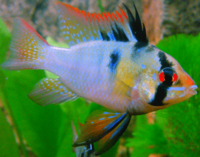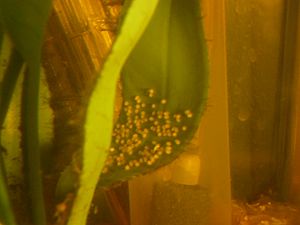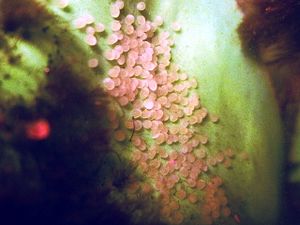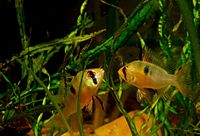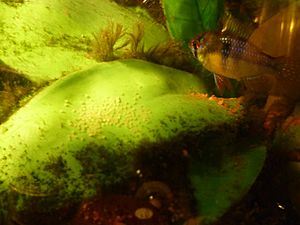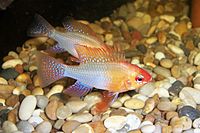Ram cichlid facts for kids
Quick facts for kids Ram cichlid |
|
|---|---|
 |
|
| Conservation status | |
| Scientific classification | |
| Synonyms | |
|
The ram cichlid, also known as Mikrogeophagus ramirezi, is a colorful freshwater fish. It lives only in the Orinoco River basin. This area is found in the savannahs of Venezuela and Colombia in South America.
People often study ram cichlids to learn about fish behavior. They are also very popular as aquarium fish. You might hear them called by many names. Some common names include ram, blue ram, German blue ram, and butterfly cichlid. This fish belongs to the family called Cichlidae.
Contents
What Does a Ram Cichlid Look Like?
Male ram cichlids usually have longer front rays on their dorsal fin (the fin on their back). However, some female rams bred for aquariums can also show this.
When a female ram cichlid is ready to lay eggs, her belly often turns pink or red. Females also have a blue shimmer over a dark spot below their dorsal fin. Males do not have this blue shimmer. Males are a bit bigger than females. These fish usually grow to be about 34 to 40 millimeters long.
Where Do Ram Cichlids Live?
The ram cichlid's natural home is in the warm waters of Venezuela and Colombia. These waters are part of the Llanos savannas. The water temperature is usually between 25.5 and 29.5 degrees Celsius (78-85 degrees Fahrenheit). The water is also a bit acidic, with a pH of 5.2 to 6.7.
The water in their habitat usually flows slowly. It does not have many dissolved minerals. The water can be clear or dark from natural plant chemicals called tannins. Ram cichlids like to live where there are lots of plants. These plants give them places to hide.
Reproduction and Life Cycle
When ram cichlids are old enough, they form pairs before laying eggs. These pairs stay together for breeding. Male ram cichlids do not like other males near their chosen partner.
These fish lay their small, sticky eggs on flat stones. They might also dig small dips in the gravel to lay eggs there. The eggs are about 0.9 to 1.5 millimeters in size.
Like many cichlids, both parents take care of the eggs and young fish. The male and female work together to guard their territory. They also tend to the eggs. A typical group of eggs has 150 to 300 eggs. Sometimes, there can be as many as 500 eggs.
Parents fan water over their eggs. This helps the eggs get enough oxygen. The eggs hatch in about 40 hours if the water is 29 degrees Celsius (84 degrees Fahrenheit).
The baby fish, called larvae, cannot swim freely for about five days. After that, the male or female parent guides them. They swim together in a close group to find food.
How Ram Cichlids Got Their Name
The ram cichlid is named after Manuel Ramirez. He was one of the first people to collect and bring these fish into the aquarium trade. In 1948, George S. Myers and R. R. Harry first described this fish. They called it Apistogramma ramirezi. Over time, the fish's scientific name changed. It was moved to different groups, including Microgeophagus and Papiliochromis.
Keeping Ram Cichlids in Aquariums
Ram cichlids are very popular in freshwater community aquariums. A community aquarium is a tank with many different types of fish. Some larger cichlids are not good for community tanks. However, a male and female pair of ram cichlids can live well with other fish.
Different Types of Ram Cichlids
Many different kinds of ram cichlids have been created. This has happened in Asia for people who enjoy fishkeeping. Some types are called gold rams or electric blue rams. These fish have special yellow or blue colors. There are also "balloon" forms, which are rounder and bigger. Other types have long fins.
However, some of these special types can have problems. They might not be able to have as many babies. They can also have more health issues. Sometimes, they do not take care of their eggs as well as wild ram cichlids do.
See also
 In Spanish: Mikrogeophagus ramirezi para niños
In Spanish: Mikrogeophagus ramirezi para niños
- List of freshwater aquarium fish species



